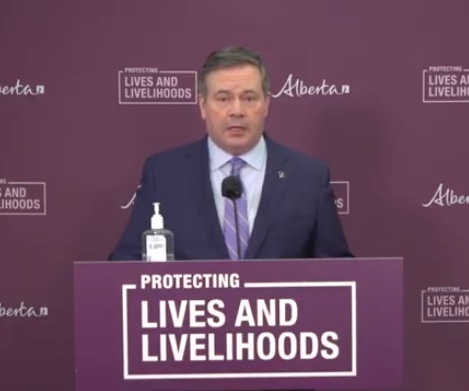Alberta
Province boosts funding to add almost 100,000 CT scans and MRI’s over the next year

From the Province of Alberta
Improving access to MRIs and CT scans
A $33-million one-time commitment from Budget 2021 will drive down wait times for Albertans needing non-emergency CT scans and MRIs in public hospitals and spark innovation to provide the best patient care.
The commitment will support AHS to perform up to 50,000 additional CT (computerized tomography) scans and up to 45,000 additional MRI (magnetic resonance imaging) scans throughout the province in 2021-22.
This work is part of an aggressive action plan developed by Alberta’s government and AHS to reduce wait times to ensure that by 2023, all Albertans have their CT scans and MRIs done within appropriate wait times recommended by medical experts.
“Albertans need better results from our health-care system, including from MRIs and CT scans that can diagnose their health condition and set them on the path to recovery. This commitment is part of Alberta’s historic investment in health care. We will ensure that all health dollars are spent wisely to support patients and families.”
“Physicians have raised the alarm that long waits put patients at risk – and we couldn’t agree more. Reducing wait times for these medically necessary diagnostic tests is not negotiable. This is why I directed AHS to implement this action plan and to work in partnership with radiologists to find innovative solutions to provide the best patient care with the significant dollars dedicated to this work.”
The additional $33 million will augment the $1 billion Alberta spends each year on diagnostic imaging. This total spend includes ultrasounds, X-rays and mammography, as well as MRIs and CT scans for Albertans.
So far, AHS and its contracted radiologists’ focused work on the action plan has meant fewer people are waiting for CT and MRI scans now compared with March 2020, a trend that will continue over the next two years.
“AHS understands how important it is for patients to receive timely access to diagnostic testing and quick turnaround of results. We are listening to all concerns and are proactively working to improve this very important service for Albertans.”
“Timely access to diagnostic imaging including CT and MRI is an essential component of quality patient care. Imaging plays an important role in the diagnosis and treatment of many medical conditions. Improved access to imaging should lead to improved care.”
“Alberta’s Radiologists welcome this initiative to decrease waitlists for CT and MRI, two critical tools in the overall function of our health-care system. Timely access to all medical imaging and image-guided procedures is so important, now more than ever.”
Alberta Health and AHS developed the CT and MRI Action Plan to address increasingly long wait times, which peaked in 2019-20, and to decrease costs, better manage demand to reduce unnecessary tests, and to make sure the people who most need the tests for treatment decisions will get the scans sooner. The implementation plan uses data to more accurately estimate where demand pressures may occur so that resources can be deployed to respond efficiently.
AHS will reinvest any cost savings achieved through the plan to where they are most needed.
Budget 2021 protects lives and livelihoods with a historic investment in health care while laying the foundation for economic growth. Through the prudent management of tax dollars, Alberta’s government can continue to invest in priority areas to ensure Alberta emerges from COVID-19 stronger than ever.
Quick facts
- Demand for CT scans in Alberta is increasing by five per cent annually, and for MRIs by 3.5 per cent annually.
- If a patient is in an emergency department and needs an urgent scan, they are able to get one quickly. If a patient is in hospital, they are able to get a scan within 24 hours.
- While wait times for patients in hospital or emergency departments are stable and within time frames recommended by medical experts, wait times for outpatients referred for a CT or MRI scan are longer than recommended.
- As of December 2020:
- 44,341 Albertans were waiting for a CT scan, down from 60,181 Albertans waiting in March 2020.
- 79 per cent of urgent out-patients were able to get their CT scans within clinically appropriate wait times.
- 41 per cent of routine out-patients were able to get their CT scans within clinically appropriate wait times.
- 59,614 Albertans were waiting for an MRI, down from 66,183 Albertans waiting in March 2020.
- 75 per cent of urgent out-patients were able to get their MRIs within clinically appropriate wait times.
- 55 per cent of routine out-patients were able to get their CT scans within clinically appropriate wait times.
- 44,341 Albertans were waiting for a CT scan, down from 60,181 Albertans waiting in March 2020.
Alberta
Made in Alberta! Province makes it easier to support local products with Buy Local program

Show your Alberta side. Buy Local. |
When the going gets tough, Albertans stick together. That’s why Alberta’s government is launching a new campaign to benefit hard-working Albertans.
Global uncertainty is threatening the livelihoods of hard-working Alberta farmers, ranchers, processors and their families. The ‘Buy Local’ campaign, recently launched by Alberta’s government, encourages consumers to eat, drink and buy local to show our unified support for the province’s agriculture and food industry.
The government’s ‘Buy Local’ campaign encourages consumers to buy products from Alberta’s hard-working farmers, ranchers and food processors that produce safe, nutritious food for Albertans, Canadians and the world.
“It’s time to let these hard-working Albertans know we have their back. Now, more than ever, we need to shop local and buy made-in-Alberta products. The next time you are grocery shopping or go out for dinner or a drink with your friends or family, support local to demonstrate your Alberta pride. We are pleased tariffs don’t impact the ag industry right now and will keep advocating for our ag industry.”
Alberta’s government supports consumer choice. We are providing tools to help folks easily identify Alberta- and Canadian-made foods and products. Choosing local products keeps Albertans’ hard-earned dollars in our province. Whether it is farm-fresh vegetables, potatoes, honey, craft beer, frozen food or our world-renowned beef, Alberta has an abundance of fresh foods produced right on our doorstep.
Quick facts
- This summer, Albertans can support local at more than 150 farmers’ markets across the province and meet the folks who make, bake and grow our food.
- In March 2023, the Alberta government launched the ‘Made in Alberta’ voluntary food and beverage labelling program to support local agriculture and food sectors.
- Through direct connections with processors, the program has created the momentum to continue expanding consumer awareness about the ‘Made in Alberta’ label to help shoppers quickly identify foods and beverages produced in our province.
- Made in Alberta product catalogue website
Related information
Alberta
Province to expand services provided by Alberta Sheriffs: New policing option for municipalities

Expanding municipal police service options |
Proposed amendments would help ensure Alberta’s evolving public safety needs are met while also giving municipalities more options for local policing.
As first announced with the introduction of the Public Safety Statutes Amendment Act, 2024, Alberta’s government is considering creating a new independent agency police service to assume the police-like duties currently performed by Alberta Sheriffs. If passed, Bill 49 would lay additional groundwork for the new police service.
Proposed amendments to the Police Act recognize the unique challenges faced by different communities and seek to empower local governments to adopt strategies that effectively respond to their specific safety concerns, enhancing overall public safety across the province.
If passed, Bill 49 would specify that the new agency would be a Crown corporation with an independent board of directors to oversee its day-to-day operations. The new agency would be operationally independent from the government, consistent with all police services in Alberta. Unlike the Alberta Sheriffs, officers in the new police service would be directly employed by the police service rather than by the government.
“With this bill, we are taking the necessary steps to address the unique public safety concerns in communities across Alberta. As we work towards creating an independent agency police service, we are providing an essential component of Alberta’s police framework for years to come. Our aim is for the new agency is to ensure that Albertans are safe in their communities and receive the best possible service when they need it most.”
Additional amendments would allow municipalities to select the new agency as their local police service once it becomes fully operational and the necessary standards, capacity and frameworks are in place. Alberta’s government is committed to ensuring the new agency works collaboratively with all police services to meet the province’s evolving public safety needs and improve law enforcement response times, particularly in rural communities. While the RCMP would remain the official provincial police service, municipalities would have a new option for their local policing needs.
Once established, the agency would strengthen Alberta’s existing policing model and complement the province’s current police services, which include the RCMP, Indigenous police services and municipal police. It would help fill gaps and ensure law enforcement resources are deployed efficiently across the province.
Related information
-

 2025 Federal Election1 day ago
2025 Federal Election1 day agoOttawa Confirms China interfering with 2025 federal election: Beijing Seeks to Block Joe Tay’s Election
-

 Energy2 days ago
Energy2 days agoIndigenous-led Projects Hold Key To Canada’s Energy Future
-

 2025 Federal Election1 day ago
2025 Federal Election1 day agoHow Canada’s Mainstream Media Lost the Public Trust
-

 Energy2 days ago
Energy2 days agoMany Canadians—and many Albertans—live in energy poverty
-

 2025 Federal Election20 hours ago
2025 Federal Election20 hours agoBREAKING: THE FEDERAL BRIEF THAT SHOULD SINK CARNEY
-

 2025 Federal Election1 day ago
2025 Federal Election1 day agoReal Homes vs. Modular Shoeboxes: The Housing Battle Between Poilievre and Carney
-

 Business2 days ago
Business2 days agoCanada Urgently Needs A Watchdog For Government Waste
-

 International2 days ago
International2 days agoPope Francis has died aged 88



